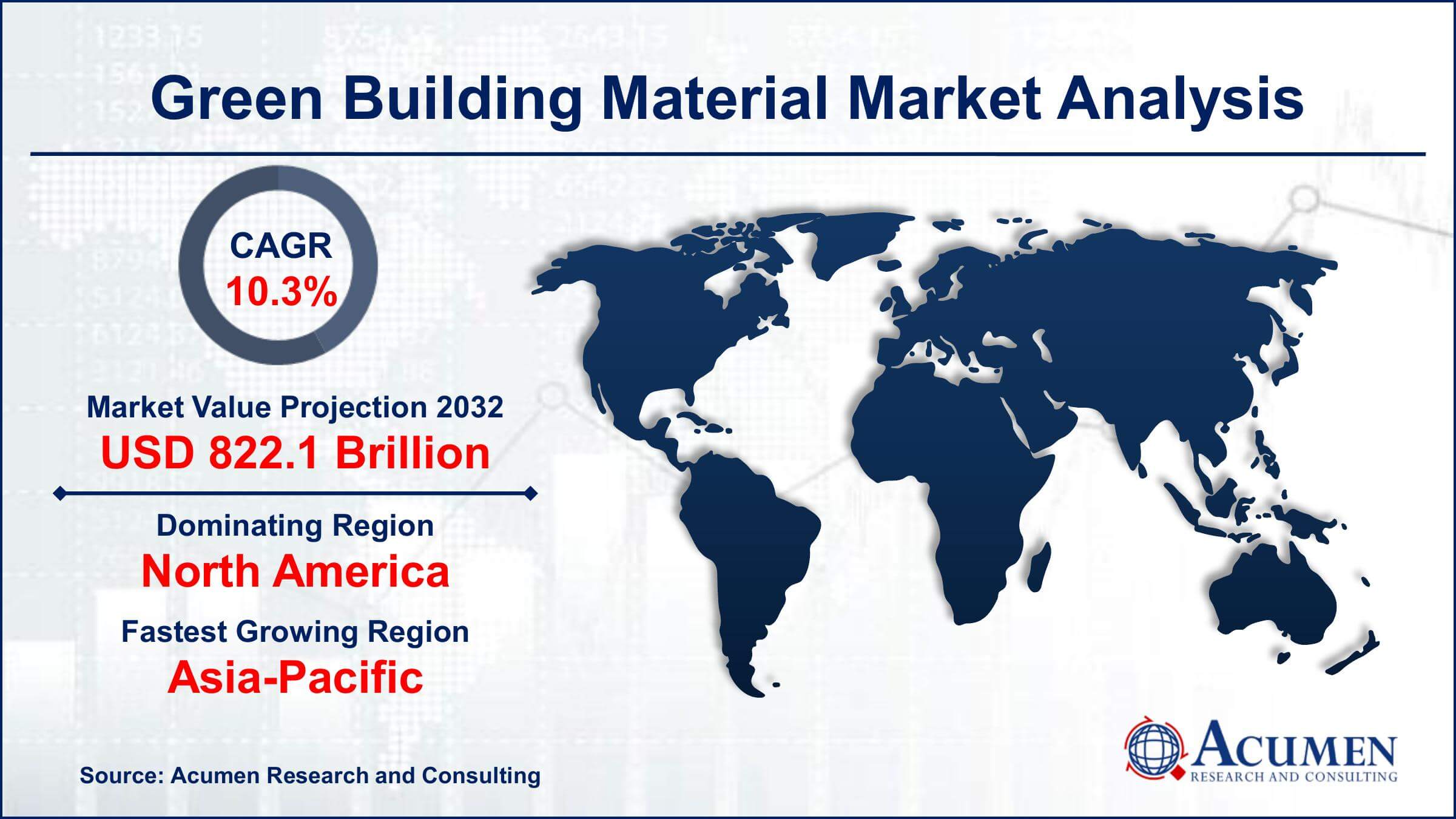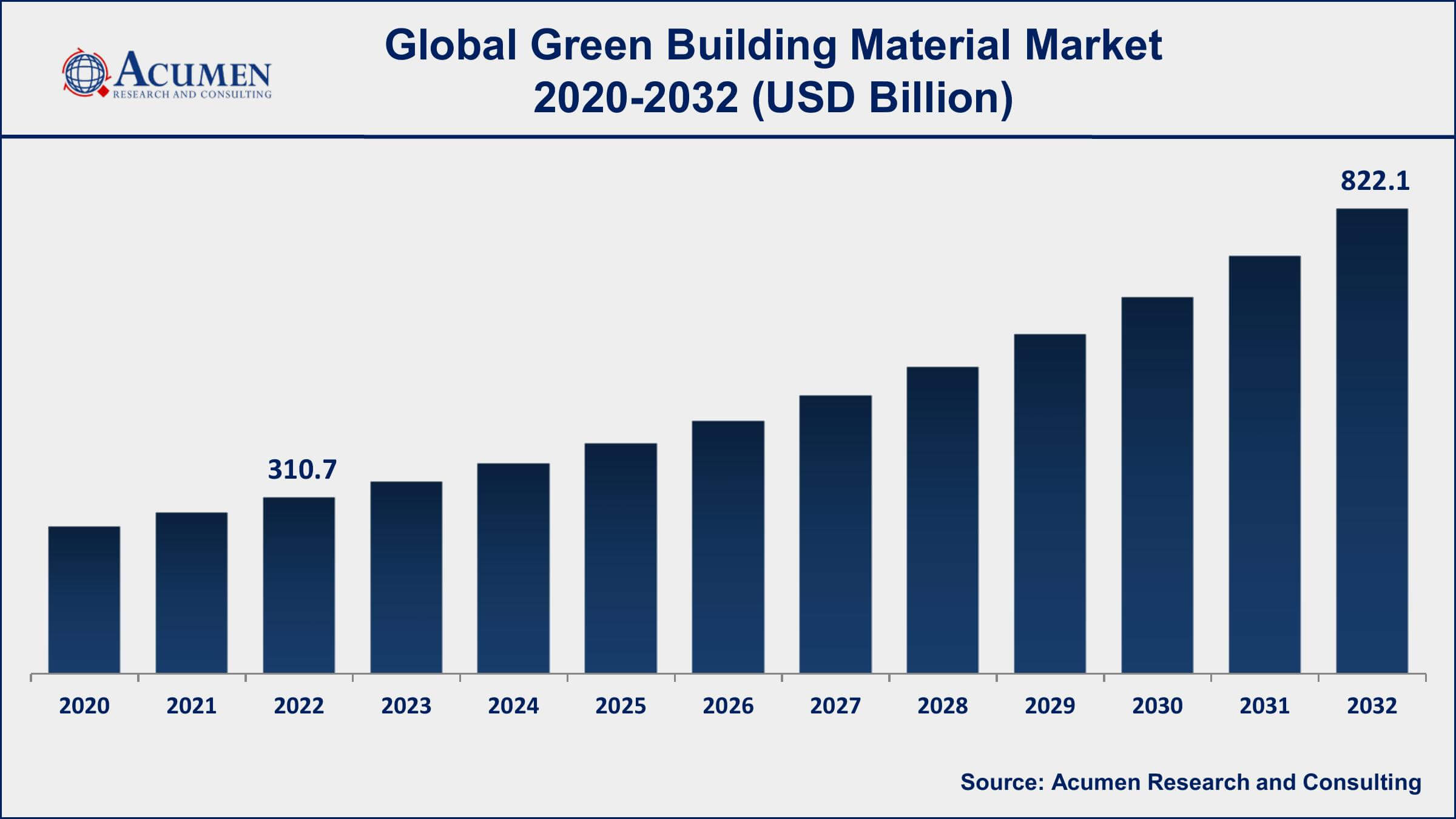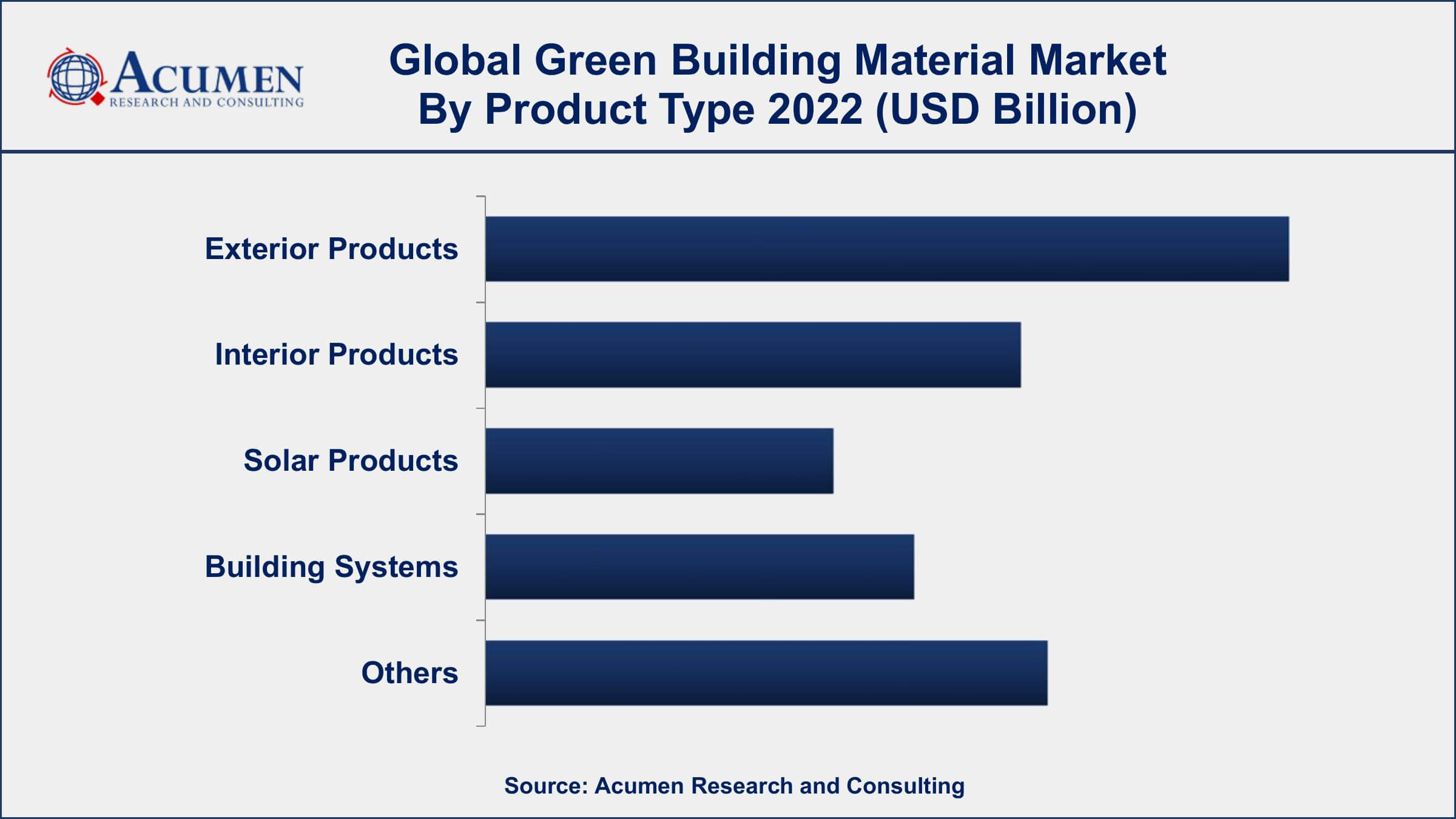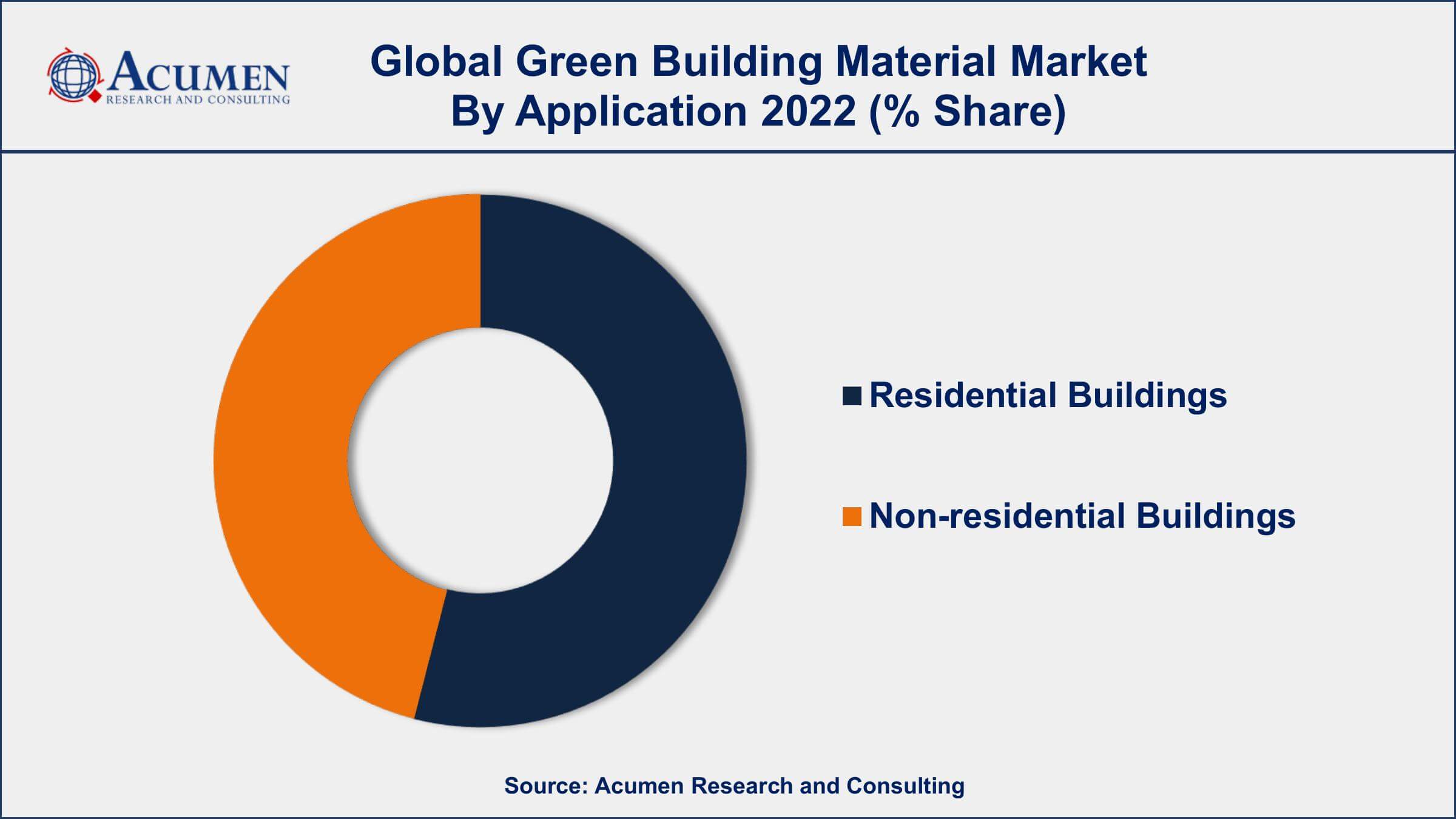Green Building Material Market Size - Global Industry, Share, Analysis, Trends and Forecast 2023 - 2032
Published :
Report ID:
Pages :
Format :
Green Building Material Market Size - Global Industry, Share, Analysis, Trends and Forecast 2023 - 2032
Report Coverage
- Industry Dynamics
- Market Size and Forecast Data
- Segment Analysis
- Competitive Landscape
- Regional Analysis with a Niche Focus on Country-Level Data
- High Level Analysis - Porter's, PESTEL, Value Chain, etc.
- Company Profiles of Key Players
- Option to Customize the Report As Per Your Specific Need
Request Sample Report
The Global Green Building Material Market Size accounted for USD 310.7 Billion in 2022 and is projected to achieve a market size of USD 822.1 Billion by 2032 growing at a CAGR of 10.3% from 2023 to 2032.
Report Key Highlights
- Global green building material market revenue is expected to increase by USD 822.1 Billion by 2032, with a 10.3% CAGR from 2023 to 2032
- North America region led with more than 39% of green building material market share in 2022
- According to a United Nations Environment Programme report, utilizing green building materials can save the construction industry up to 40% on energy expenses
- According to the study, building material production accounts for 11% of worldwide greenhouse gas emissions
- Buildings are responsible for 39% of all energy-related CO2 emissions worldwide, thus using green building materials can help mitigate this effect
- Growing demand for net-zero energy buildings and carbon-neutral construction, drives the green building material market size

Green building materials are sustainable, eco-friendly products and technologies that are used to construct and renovate buildings. These materials are designed to minimize the negative impact on the environment and human health while providing high levels of durability, energy efficiency, and performance. Examples of green building materials include recycled steel, bamboo, straw bale, and energy-efficient windows and insulation. By using green building materials, architects, engineers, and builders can create healthier, more comfortable living spaces that consume less energy and water, and produce less waste and pollution. The global green building materials market has been experiencing significant growth over the past few years, driven by several factors such as increasing government initiatives and regulations, growing consumer awareness and demand for sustainable materials, and rising concerns over climate change and environmental degradation.

Global Green Building Material Market Trends
Market Drivers
- Increasing government initiatives and regulations for sustainable construction
- Growing consumer awareness and demand for eco-friendly building materials
- Rising concerns over climate change and environmental degradation
- Improved performance and durability of green building materials
Market Restraints
- High upfront costs of green building materials and technologies
- Limited availability and access to some green building materials
Market Opportunities
- Development of new and innovative green building materials and technologies
- Growing demand for net-zero energy buildings and carbon-neutral construction
Green Building Material Market Report Coverage
| Market | Green Building Material Market |
| Green Building Material Market Size 2022 | USD 310.7 Billion |
| Green Building Material Market Forecast 2032 | USD 822.1 Billion |
| Green Building Material Market CAGR During 2023 - 2032 | 10.3% |
| Green Building Material Market Analysis Period | 2020 - 2032 |
| Green Building Material Market Base Year | 2022 |
| Green Building Material Market Forecast Data | 2023 - 2032 |
| Segments Covered | By Product Type, By Application, And By Geography |
| Regional Scope | North America, Europe, Asia Pacific, Latin America, and Middle East & Africa |
| Key Companies Profiled | Interface Inc., Alumasc Group Plc, RedBuilt, LLC, Bauder Limited, Kingspan Group plc, CertainTeed Corporation, PPG Industries, Binderholz GmbH, Forbo International SA, Owens Corning, BASF SE, DuPont, and National Fiber. |
| Report Coverage |
Market Trends, Drivers, Restraints, Competitive Analysis, Player Profiling, Covid-19 Analysis, Regulation Analysis |
Green building is a technology that is used to build eco-friendly and energy-efficient buildings. The purpose of green buildings is to reduce the negative impact on human health. Environment-friendly materials are used in developing green buildings. Rainwater harvesting and green roof techniques are well adapted by consumers in arrears to repeated climate fluctuations and thrilling weather conditions. But the non-availability of eco-friendly and high-performance green building materials is the main factor that hampers the growth of this market. Furthermore, the construction cost required for green buildings is more than compared for normal buildings. North American and European Governments adopted stringent regulations for shifting towards green building technology; such factors are the signs of massive growth in this sector. The future market of green building materials would be driven by various attempts by NGOs and societies to increase awareness for acceptance of sustainable technology.
The positive effect of green building on human health is the main driving factor for the growth of the green building material market value. The market for green building technology is driven by extreme weather conditions, recurrent climate changes, and, consumer preference for the adoption of green roof equipment to sustain temperature within the infrastructure. Rainwater harvesting is another important factor adding to the benefit of the green building concept. However, the unavailability or limited availability of high-performance and eco-friendly materials required for green buildings is the key factor that restricts the growth of the green building market. Moreover, the high cost associated with green building materials and strict regulatory norms are the other factors affecting the green building material market growth.

Green Building Material Market Segmentation
The global green building material market segmentation is based on product type, application, and geography.
Green Building Material Market By Product Type
- Exterior Products
- Siding
- Windows
- Doors
- Roofing
- Interior Products
- Insulation
- Floorings
- Solar Products
- Building Systems
- Others

In terms of product types, the exterior products segment has seen significant growth in the green building material market in recent years. This segment includes products that are used to construct and enhance the exterior of buildings, such as roofing, siding, windows, doors, and landscaping materials. The growth of the exterior products segment in the green building materials market can be attributed to several factors. One of the primary drivers is the increasing demand for energy-efficient and sustainable buildings. As more building owners and developers seek to reduce energy consumption and greenhouse gas emissions, they are turning to green building materials that offer better insulation, ventilation, and natural lighting. Another key driver of growth in the exterior products segment is the increasing availability and affordability of green building materials. As manufacturers invest in research and development, they are producing new and innovative products that are both sustainable and cost-effective.
Green Building Material Market By Application
- Residential Buildings
- Non-residential Buildings
- Institutional
- Commercial & Office
- Hospitality & Leisure
- Industrial
- Others

According to the green building material market forecast, the residential buildings segment is expected to witness significant growth in the coming years. This segment includes materials used in the construction and renovation of homes, apartments, and other residential buildings. The growth of the residential buildings segment in the green building materials market can be attributed to several factors. Firstly, there is an increasing demand for sustainable homes and apartments among consumers. Homeowners and renters are becoming more environmentally conscious and are seeking out properties that are energy-efficient, healthy, and sustainable. This trend is particularly pronounced among millennials and younger generations, who are more likely to prioritize environmental sustainability when choosing a home. Another key driver of growth in the residential buildings segment is the increasing availability and affordability of green building materials.
Green Building Material Market Regional Outlook
North America
- U.S.
- Canada
Europe
- U.K.
- Germany
- France
- Spain
- Rest of Europe
Asia-Pacific
- India
- Japan
- China
- Australia
- South Korea
- Rest of Asia-Pacific
Latin America
- Brazil
- Mexico
- Rest of Latin America
The Middle East & Africa
- South Africa
- GCC Countries
- Rest of the Middle East & Africa (ME&A)
Green Building Material Market Regional Analysis
The Asia-Pacific region is dominating the green building materials market due to several factors. One of the primary reasons is the growing awareness of environmental issues and sustainability in the region. As the population and economy continue to grow in countries such as China, India, and Japan, there is a greater emphasis on reducing environmental impacts and improving quality of life. This has led to an increase in demand for green building materials, which can help to reduce energy consumption and greenhouse gas emissions.
Another key factor contributing to the dominance of the Asia-Pacific region in the green building materials market is the strong government support for sustainable construction. Many countries in the region have implemented regulations and incentives to encourage the use of green building materials, such as tax credits, subsidies, and green building certification programs. This has created a favorable environment for green building materials manufacturers and suppliers and has helped to drive innovation and investment in the sector.
Green Building Material Market Player
Some of the top Green Building Material market companies offered in the professional report include Interface Inc., Alumasc Group Plc, RedBuilt, LLC, Bauder Limited, Kingspan Group plc, CertainTeed Corporation, PPG Industries, Binderholz GmbH, Forbo International SA, Owens Corning, BASF SE, DuPont, and National Fiber.
Frequently Asked Questions
What was the market size of the global green building material in 2022?
The market size of green building material was USD 310.7 Billion in 2022.
What is the CAGR of the global green building material market from 2023 to 2032?
The CAGR of green building material is 10.3% during the analysis period of 2023 to 2032.
Which are the key players in the green building material market?
The key players operating in the global market are including Interface Inc., Alumasc Group Plc, RedBuilt, LLC, Bauder Limited, Kingspan Group plc, CertainTeed Corporation, PPG Industries, Binderholz GmbH, Forbo International SA, Owens Corning, BASF SE, DuPont, and National Fiber.
Which region dominated the global green building material market share?
North America held the dominating position in green building material industry during the analysis period of 2023 to 2032.
Which region registered fastest CAGR from 2023 to 2032?
Asia-Pacific region exhibited fastest growing CAGR for market of green building material during the analysis period of 2023 to 2032.
What are the current trends and dynamics in the global green building material industry?
The current trends and dynamics in the green building material industry include increasing government initiatives and regulations for sustainable construction, as well as growing consumer awareness and demand for eco-friendly building materials.
Which product type held the maximum share in 2022?
The exterior product type held the maximum share of the green building material industry.


